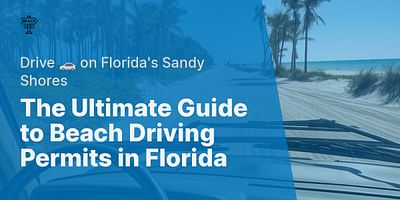Annabelle is an avid beach explorer with a deep-seated love for coastal adventures. With over ten years of beach driving experience, she holds an extensive reservoir of knowledge about the topic. Her expertise is a guiding light for beach lovers looking to make their driving experiences safe and memorable.
Yes, there are specific rules and regulations for driving on the beach in your state. It's important to familiarize yourself with these rules to ensure a safe and enjoyable beach driving experience.
Beach driving regulations vary from state to state, so it's crucial to know the specific rules for the state you plan to visit. Some states have designated areas where beach driving is allowed, while others may have restrictions or even prohibit it altogether. To find out the beach driving regulations in your state, you can check the official website of the state's Department of Natural Resources or Department of Environmental Protection.
Here are some common beach driving rules and regulations you should be aware of:
1. Observe speed limits: Most states have speed limits for driving on the beach, typically ranging from 10 to 25 miles per hour. It's important to adhere to these speed limits to ensure the safety of pedestrians, wildlife, and other beachgoers.
2. Stay in designated areas: Many beaches have specific areas designated for beach driving. These areas are usually marked by signs or roped-off sections. It's important to stay within these designated areas and avoid driving on dunes, protected habitats, or areas where vehicles are prohibited.
3. Observe nesting seasons: Some beaches have designated nesting areas for sea turtles or other protected wildlife. During nesting seasons, certain sections of the beach may be off-limits to vehicles to protect these animals and their habitats. It's important to respect these restrictions and avoid driving in these areas during nesting seasons.
4. Obtain necessary permits: In some states, you may need a permit to drive on the beach. These permits are typically issued by the local authorities and may have specific requirements, such as vehicle inspections or proof of insurance. Make sure to check if a permit is required and obtain one before driving on the beach.
5. Practice safe beach driving: When driving on the beach, it's important to follow safe driving practices. This includes keeping a safe distance from other vehicles and pedestrians, avoiding sudden maneuvers or excessive speed, and being aware of the beach conditions, such as soft sand or tidal changes.
Remember, beach driving rules and regulations are in place to protect the environment, wildlife, and the safety of all beachgoers. By following these rules, you can have a safe and enjoyable beach driving experience while minimizing any negative impact on the beach ecosystem.
If you have any specific questions about beach driving regulations in your state, it's always a good idea to contact the local authorities or visit the official website of the state's Department of Natural Resources or Department of Environmental Protection. They will have the most up-to-date and accurate information regarding beach driving rules and regulations in your area.
Safe travels and enjoy your beach driving adventures!














